Clinical
Examination of the cow

 268-275 268-275
 History History
- In getting a history, is it available? Some
producers have few, if any, written records and may rely too much on
memory. You can use your previous experience with the producer to
determine if the history is accurate. A written record is always
preferred, as "A dull pencil is better than a sharp mind".

- The expected status of the animal can aid in
your examination, but should not prejudice you in your findings.
- Is the cow post partum (just calved), if so
what is the calving date?
- Is this a pregnancy exam, if so what is the
breeding date? You must be a skilled in determining pregnancy status
as sometimes the cow is pregnant to a different breeding date than
you are given.....if you are given one at all.
- Is the cow a 'repeat breeder' What is her
history of repeat breeding.... when, how often?
- Is the cow being examined for anestrus? What is
the heat detection history? Is there any history of breeding or bull
exposure? Was it born a twin?
- Is this a purchase exam?
- What is the cow's temperament? Is she a
kicker?? This would certainly be nice to know before you are lying
on the ground in pain with the farmer looking on (usually they think
it is funny when the vet gets kicked!!) with a sheepish look.

- What is the age of the cow? A cow may be
examined for different reasons than a heifer.
Visual examination
- Many times you will be too preoccupied and not
do a visual exam. This can be most embarrassing not to do. You can
often estimate the age and determine whether it is a cow,
heifer.....and make sure it is not a bull that you are pregnancy
checking!
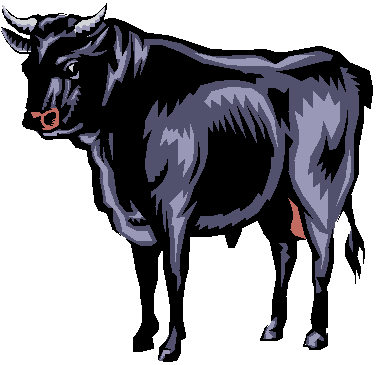
- Look at the conformation. Is it normal, or does
it look more steer-like? Is there a sloped tail head, small vulva,
enlarged clitoris, or long vulvar hair? These are all suspicious
signs of a freemartin.
- Look at the udder. Is
it large, indicating a post partum cow or is
it small suggesting a heifer or dry cow?
- Look for vulvar discharge. Is there any? If
there is some, is it clear mucus, cloudy mucus, blood, normal lochia,
or pus? Take a whiff.....it can tell you a lot about the meaning of
the discharge.
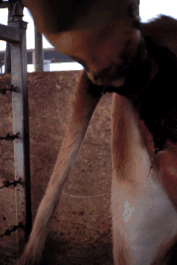 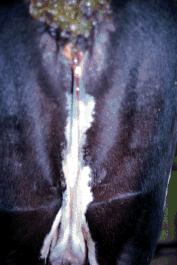
Mucus on tail. Metestrus blood in mucus.
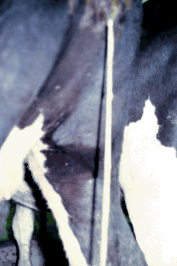 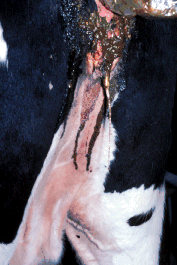
Pus discharge. Slight pus discharge.Rectal
palpation
- Why do we emphasize rectal palpation so much
(actually it is palpation of the uterus per rectum.....rectal
palpation means palpating the rectum.......I will stop now) ?
- Rectal palpation is currently the fastest,
cheapest, most accurate, and easiest technique to accurately assess
the condition of the uterus.
- It is best to use the opposite hand with which
you write, because you are usually more dexterous with the hand with
which you write and you can do things better with that hand. Since
you cannot palpate yet, you may as well train your 'other' hand to be
more useful.
- The landmarks for palpation are the pelvic
floor and the iliac shafts. The cervix is 8-12 cm x 4-6 cm on pelvic
floor and consists of cartilage which gives it the firm feel of a
"turkey neck". It is always firm and on the pelvic floor.
- The broad ligament is a sheet of tissue
extending from uterus and ovaries to the body wall. It may be at 450
or almost ventral. You need to identify it !!! The middle uterine
artery runs in it.
- Other normal structures include the external
iliac artery, pelvic lymph nodes, the rumen, the ceacum, the bladder,
and the kidney.
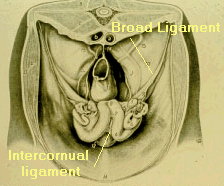
Procedure
for Indirect Uterine Retraction of the Bovine Uterus

Click here, then right click on the frame to see a
video on retraction.

- Put on a sleeve .....please! At some places you
will be asked to use a new sleeve on each cow. Why?
- Lube your hand well. You usually need to lube
on the first cow only. Usually one sleeve is used as long as
possible. There is some evidence however, that there may be some
diseases spread by rectal palpation, so this may change during your
careers.
- Point your fingers and insert one finger, then
your hand into the rectum.
- Now make a fist and ram your stiffened arm into
the cow. This will help conserve energy. Try to go under feces if
possible, as this will also conserve time and energy.
- Remove excess feces without
removing your hand.
- Grasp the cervix and pull it backward.
- Place your thumb under the cervix.
- Fan your hand out laterally about 450
or almost ventrally to engage the broad ligament.
- Pull back on the broad ligament.
- The uterine horn and the ovary are now within
your grasp, but disregard the ovary and move your hand medial to the
ventral
intercornual ligament.
- Drive your
hand down between the uterine horns to the
ventral
intercornual ligament.
- Pull caudally on the ligament to pull uterus
back. Flip the uterus over so that tips of horns and cervix are
pointing caudally.
- Now you can systematically palpate the horns,
ovaries, oviducts, and bursa.
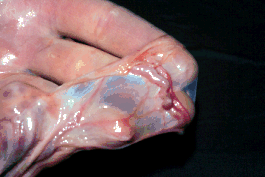 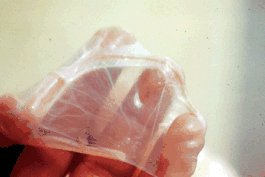
Oviduct and bursa palpation.
Direct retraction
- Direct retraction may work on smaller, non
pregnant tracts, but it is not the method to learn first.
- Pull back on cervix and reach directly for the
ventral
intercornual ligament.
- Pull the uterus back and flip over as before.
Palpable changes in normal cycling cow
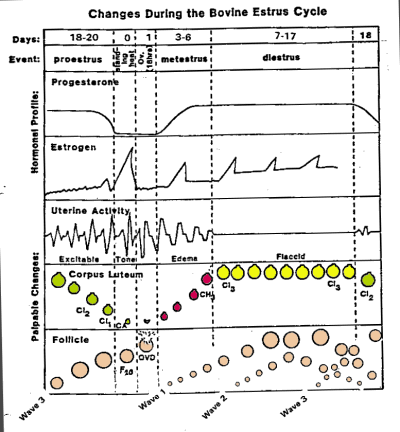
Click to enlarge

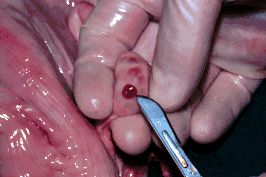 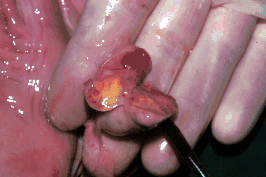
Corpus hemorragicum (CH), intact and cut surface.
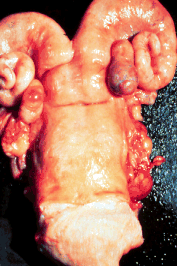 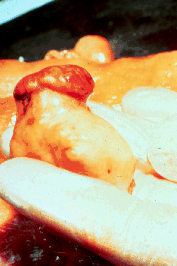 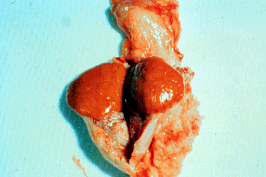
Corpus luteum (CL3) on right ovary, palpation, cut surface.
-
Sensitivity and Specificity of Rectal Palpation to
Determine the Presence of a
Mature Corpus Luteum in Cycling Cows
- If we look
at the sensitivity and specificity of either of these tests, we find
that they are probably not cost beneficial. The cost of the mistakes
outweighs the cost of palpation.
- For example, looking at the figure
and using a sensitivity of 83% and a specificity of 53% for rectal
palpation identification of a corpus luteum (both figures are what
good palpators can achieve) we see that in a random cycling herd of
21 cows, 10 would have corpora lutea and 11 would not.
- Palpation
would say that 13 have a corpus luteum and 8 do not.
- That means that we correctly
identify 8/10 CLs, but miss 6/11 when we say they do
not have a CL.
|
|
Corpus Luteum Present
|
|
|
Palpate
Corpus Luteum
|
Yes
|
No
|
Totals
|
|
Yes
|
8
|
5
|
13
|
|
No
|
2
|
6
|
8
|
|
Totals
|
10
|
11
|
21
|
- Sensitivity of 83%
- Specificity of 53%
- Positive predictive value of 61%
- Negative predictive value of 75 %
Ultrasound
examination
-
Becoming
more
popular
for
pregnancy
diagnosis
and
ovarian
structure
identification.
-
Dairy
primarily.
-
Pixel
values
of
ultrasound
images
of
corpora
lutea
were
correlated
with
luteal
(r =
-0.72,
P <
0.05)
and
plasma
(r =
-0.71,
P <
0.03)
progesterone
concentration,
and
to
the
volume
densities
of
luteal
cells
(r =
-0.75,
P <
0.02)
and
connective
tissue
(r =
0.69,
P <
0.03)
(Ultrasound
image
attributes
of
the
bovine
corpus
luteum:
structural
and
functional
correlates.J
Singh,
RA
Pierson,
and
GP
Adams
.
Journal
of
Reproduction
and
Fertility
(1997)
109
35-441997.)
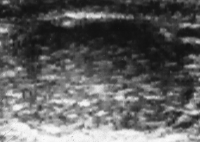
Bovine corpus luteum
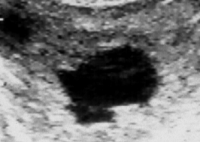
Bovine corpus luteum with central lacuna
Vaginal
examination

- Usually use a vaginal speculum. It can be made
of glass, PVC or cardboard.
- Insert the speculum over pelvis and into the
vagina. The vagina is a potential space, inserting the speculum will
cause a rush of air to 'inflate' the vagina.
- Use an external light source to look into the
vagina.
- You can look for discharge from cervix and
vagina, urine pooling, cervical ring eversion, adhesions, tears, and
abscesses.
- Manual vaginal exam. You can insert a clean
hand into vagina and instead of looking you can feel for tears,
adhesions, abscesses, cervical dilation, and debris (such as mummy,
fetus).
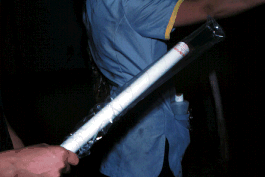 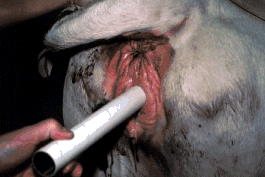 Hormonal
Concentrations Hormonal
Concentrations
- GnRH, LH, FSH, PGF,
are all experimental now. Their release may be episodic so you need
more than one sample to accurately determine the true concentration
and activity.
- Estrogen is
difficult as the assay is hard to do and there are many cross
reactions. There are no 'in house' kits , so you need to send the
sample to a lab for assay. This will take some time to get back
results.
- Progesterone
is generally accurate. There used to be qualitative on farm kits available
at about $3/test. They generally gave good results, but are not
marketed now. You needed to have
someone run the test that used good laboratory techniques to give
accurate results.
|